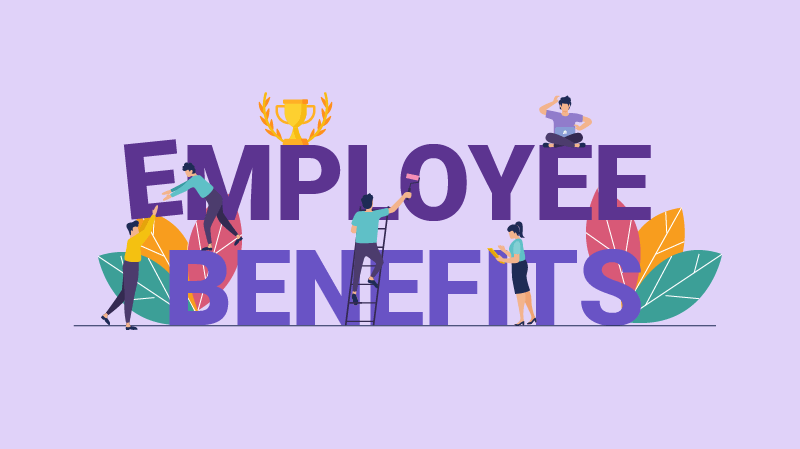Top 10 Noteworthy Fringe Benefits for your Workforce in 2024
With an aim of enhancing employee engagement, organizations have implemented a myriad of innovative measures. Among these, the strategic provision of “fringe benefits” stands out as an impactful approach.
In fact, effective fringe benefits programs have emerged as a crucial determinant of an organization’s ability to attract and retain talent.
Key Takeaways
- Meaning of fringe benefits
- A comprehensive list of tax-free fringe benefits
- Popular providers of the respective fringe benefits
What are these Fringe Benefits?
Employee fringe benefits are the tangible or intangible perks that institutions provide their workforce in addition to their salaries. Companies also provide these benefits to compensate for any work-related expenses that the employees may bear.
Some common fringe benefits include health insurance, retirement plans, paid-time off. It can also include perks like access to the company car, cell phones, in-house gyms, subsidized cafeteria plans and more.
Despite the fact that all employees within a company are eligible for specific fringe benefits, numerous organizations still differentiate these privileges according to an employee's seniority and position within the company.
Another question that arises is that if these benefits are taxable?
Here the answer is “YES”!
Most of the fringe benefits may come under the domain of taxation based on the tax rules applied in your country of operation.
Like for taxable fringe benefits in the US, the receivers must mention the market value of the availed benefits in their taxable income of the year. And this has to be done in accordance with IRS Publication 15-b.
But, there’s also a list of few tax-exempted fringe benefits that you can consider for curating a lucrative employee benefits plan.
Here are some of the tax-free fringe benefits and why you should count them in your employee benefits package.
1. Employee Health Insurance Benefits
67% of employees and 68% of employers believe this to be the most important benefits.
Employee health insurance benefits are the cornerstone of any employee benefits plan. Many employees and job seekers view it as one of the lucrative employee benefits that attract them to be a part of the organization.
And hence, with this, hiring and retaining the best talents becomes an easy affair.
Ways to Offer Health Insurance Plans
According to Business News Daily, here are some prominent players in the health insurance sector that you may consider:
Offer assistance in navigating the enrollment process and addressing any queries related to the health insurance plans.
2. Exclusive Employee Discounts
Corporate employees are always on the potential watchlist of every major brand. These brands generally include names from lifestyle, automobile, healthcare, and other industries.
And for nurturing their consumer base amongst the corporations they offer a lot of employee-only deals and discounts.
Hence, giving your employees access to these privileges will not only help them save their hard-earned income to some extent but will also alleviate their own stature as employees of your organization.
Ways to Offer Exclusive Employee Discounts
Here are few notable companies that specialize in providing comprehensive employee discount programs.
Three of these platforms offer exclusive employee discounts. But Vantage Perks takes employee discount programs a step further by offering a comprehensive and personalized experience that caters to the diverse needs and preferences of your employees.
You’ll be interested to know that Vantage Perks not only offers a user-friendly interface for smooth navigation and redemption. But empowers your HR team with advanced analytics and comprehensive reporting capabilities.
This facilitates streamlined benefit administration and provides insightful data on employee engagement and participation trends

3. Employee Retirement Plan Benefits

77% of working Americans view retirement as the most essential.
We all spend our lives working and saving up a generous part of our earnings for enjoying a better life later.
Retirement plans have always been one of the top investment criteria for every employee. These plans carry the dreams and aspirations of employees that they want to pursue once they retire.
Therefore, including the same in your employees' benefits plan would be a sure win-win case for both you and your employees.
Moreover, you can also count it as a gift back to your hard-working employees for their years of service to the organization.
Ways to Offer 401(k) Retirement Savings Plans
Forbes, recent research may assist you in identifying the leading choices for 401(k) retirement plan benefits. Here is the top 3 from the list:
4. Corporate Education Assistance

According to SHRM, 48% of companies provide undergraduate or graduate tuition assistance programs.
A major part of today's workforce comprises millennial employees. One thing that sets these millennials apart is their will to keep on learning and progressing. They learn from their current jobs, nurture their expertise, and head back to academics for better prospects.
In this process, employers lose many talented employees capable of taking their organizations further ahead.
However, supporting these employees with corporate education assistance is the best way to retain them.
Extending education assistance to your employees will help them progress professionally. Further, it'll also create a positive image about their organization, thus earning their trust and loyalty.
Ways to Offer Corporate Education Assistance
The primary factors influencing user contentment for Online Learning Platform products are “Ease of Use", "Progress Reports", "White Labeling", and "Education ERP System". Considering these factors G2 has released a list of best online learning platforms for the workforce. Here are the top 3 platforms:
5. Employee Stock Options
Employee Stock Ownership Plans (ESOPs) are a wonderful addition to the fringe benefits you offer your employees. The underlying premise of assuring a prosperous future via hard effort resonates with ESOPs.
These plans encapsulate employees' aspirations, symbolizing their envisioned post-retirement endeavors.
Integrating ESOPs into your benefit structure will empower employees to align their efforts with the organization’s. Such a benefit can also stand as a testament to your appreciation for your employees.
Ways to Offer Employee Stock Option Plan
Implement ESOPs by granting eligible employees ownership in the company through allocated shares. Regularly communicate the program's benefits and educate employees on how ESOPs contribute to their financial well-being and the company's growth.
Create a clear communication strategy that emphasizes how ESOPs align with the company's growth. Also, how employees' ownership ties into the organization's success.
6. Sponsored Life Insurance Coverage
Sponsored life insurance coverage is one of the most common fringe benefits that most employers provide their employees. This fringe benefit is a must for organizations requiring their employees to travel frequently or get involved in any hazardous work.
Life insurance cover gives an employee a sense of relief when he/she is on duty. Further, it’ll also positively impact the employer-employee relationship which is the base of every successful organization.
Ways to Offer Life Insurance Coverage
According to U.S News & World Report, here are some life insurance companies renowned for their commitment to providing reliable coverage:
Ensure thorough and transparent communication about the coverage details. This includes the coverage amount, beneficiaries, and any additional options available. Such transparency fosters trust and helps employees make informed decisions about their insurance needs.
7. Employee Assistance Programs
86% of the employees reported having a positive impact on their well-being after the implementation of EAPs.
If your employees are dealing with personal or work-related stress, consider offering them with an Employee Assistance Programs (EAPs). EAPs offer confidential counseling and support services to employees.
These programs offer a safe space for employees to seek assistance with personal or work-related challenges. Assistance may range from stress management to other mental health concerns.
Programs like EAPs contribute to reducing absenteeism and workplace conflicts. Further, creating a more harmonious and productive work environment.
Ways to Offer Employee Assistance Programs
To facilitate access to EAP, there are several EAP providers. Here are a few of the notable EAP providers that have established themselves as leader in this field:
8. Transportation Benefits
Employers can substantially reduce commuting expenses for their workforce by providing options like transit passes or carpooling. With shorter and more affordable commutes, employees not only save time but also costs as well.
Moreover, transportation benefits can also reduce financial stress among employees.
Apart from resolving employee’s commuting issues, this benefit bolsters the company's image and appeals to socially conscious consumers and investors.
All in all, transportation benefits stand out as practical and valuable fringe benefits that go beyond monetary compensation. It makes a significant difference in employees’ lives and contributes to a thriving workplace culture.
Ways to Offer Transportation Benefits to Employees
To provide employee with transportation benefits, your company can tie up with local transportation services or may consider using the services of the following:
9. Dependent Care Assistance

The pressure of juggling work responsibilities with the care of dependents can be emotionally draining and financially taxing.
By offering dependent care assistance, employers extend a helping hand to alleviate these challenges.
A typical component of dependent care aid is financial assistance in the form of subsidies or reimbursements for childcare, daycare, or eldercare expenses.
Furthermore, some employers may provide access to on-site childcare facilities or partnerships with nearby care providers. Thus, making it easier for employees to attend to the requirements of their dependents while at work.
Ways to Offer Dependent Care Assistance
To assist you in covering dependent care expenses, here are some reputable Dependent Care Assistance providers:
Offer a range of flexible options that cater to diverse caregiving needs. Recognize that employees have varying responsibilities, from childcare to eldercare. Empower your employees to select the assistance that best fits their unique situations.
10.Employee Food Allowance/ Meal Benefits
According to Fortune Business Insights, the global meal vouchers & employee benefits solutions are anticipated to grow from USD 221.99 billion in 2023 to USD 346.65 billion by 2030. Exhibiting a CAGR of 6.6% during the forecast period.
Enhancing your employees' well-being, meal benefits offer a practical and thoughtful addition to their compensation. Meal benefits not only satiate hunger but also symbolize a tangible appreciation for your employees' hard work.
Further, elevating their workplace experience and fostering a stronger bond between their efforts and the organization's growth.
Ways to Offer Meal Benefits
Meal benefits may be offered via meal vouchers or partnerships with nearby caterers. Some popular players operating in meal vouchers industry are:
Conclusion
The function of fringe benefits in influencing the modern job landscape is critical. These additional benefits go beyond mere salary, enriching the work environment and increasing employee happiness.
From health insurance to flexible work arrangements, fringe perks demonstrate a company's commitment to the well-being and engagement of its workers.
FAQs

1. Are fringe benefits deducted from paycheck?
Depending on the perk and the company's policy, fringe benefits may or may not be deducted from an employee's paycheck. Some fringe benefits, such as health insurance payments, may be deducted from a salary, whilst others, such as company-sponsored activities or gym memberships, are not.
2. What is the method to calculate fringe benefits?
To calculate fringe benefits add the total cost of the benefits and payroll taxes the employee receives. Divide that number by the wages or salary the employees earn in a year. Finally, multiply the number you generate by 100 to get the percentage
3. Are fringe benefits compulsory for employers to provide?
Employers are not compelled to give fringe benefits in general, with the exception of some benefits mandated by law, such as Social Security contributions.
4. Is it possible for employees to make changes or adjustments to fringe benefits at a later point in time?
Yes, employees often have the opportunity to make changes or adjustments to their chosen fringe benefits during specific periods, such as open enrollment periods or life-changing events like marriage or childbirth.


















